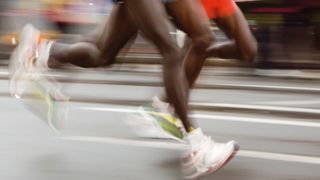From 4G to 4K: exploring the tech behind the 2014 Commonwealth Games
Virgin Media and Virgin Media Business going for gold

As the 2014 Commonwealth Games draws to a close, we take a look at how its official partner Virgin Media, along with Virgin Media Business, pulled out all the stops to make this year's event a digital one - including allowing people to race a larger-than-life Usain Bolt on a digital screen.
The BBC Commonwealth Games 4G trial
The BBC tested out live broadcasting over 4G for the Games through a partnership with EE at a public demonstration event in Glasgow.
Carried out to demonstrate how the tech would theoretically work on consumer devices if picked up by members of the public, the trial allowed attendees to view streams of real-time events that were viewable on a custom-built Commonwealth games app installed on demonstration handsets.
Additionally, the BBC's R&D unit showed off its Ultra-HD broadcasting capabilities through a public showcase in the city, broadcasting the games in 4K using technology not yet readily available in homes.
"Virgin Media Business provided 40GB connectivity from the Commonwealth Games stadia to the BBC's R&D facilities in Glasgow and Salford, powering Ultra-HD broadcasting – otherwise known as 4K TV," Duncan Higgins, marketing director at Virgin Media Business, told TechRadar Pro.
"Most of this high-speed connectivity is running over fibre optic, with Virgin Media Business providing individual fibre lengths ranging between 1km and 43km. It's great to be a part of the first public R&D production ever to be showcased live, giving people the opportunity to see the action in up to four times as much detail as standard HD."
The Race Bolt experience

Visitor to the Commonwealth Games were given the chance to put their running abilities to the test against a larger-than-life Usain Bolt on a professional quality 30 metre athletics track, while Usain himself raced on a 30 metre x 3 metre LED screen.
Are you a pro? Subscribe to our newsletter
Sign up to the TechRadar Pro newsletter to get all the top news, opinion, features and guidance your business needs to succeed!
Usain was originally filmed with a camera on a rig mounted to a quad, which was driven alongside the running track. This footage was "cut out" against a green-screen background frame by frame to be transferred onto the Race Bolt screen.
The screen contained motion sensors, which captured the runner at several stages throughout their race with Bolt – from them sitting up to run, mid-way and as they cross the finish line – to match them with Usain's speed.
Infrared sensors ensured that the runner's height, size and technique were all captured, giving each challenger an overall run time. They had a something of a task on their hands, however, as Usain himself can run 30 metres in just 3.8 seconds.
The Switched on Futures campaign
Virgin Media supported the Switched On Futures campaign during the 2014 Commonwealth Games, a national campaign to help boost digital skills through the inspiration of sport that was launched in Glasgow, a city one of the lowest levels of broadband usage in the UK.
The campaign covers two areas. First, it aims to deliver digital skills to older and disabled people through local sports clubs, with new, benefit-driven training materials, demonstrating the benefits of the digital world in a simple to understand manner.
It also aims to encourage non-technically minded children to get involved in coding through a partnership with coding club CoderDojo, which involved games based around Microsoft's Kinect and programming movements through sensors.

